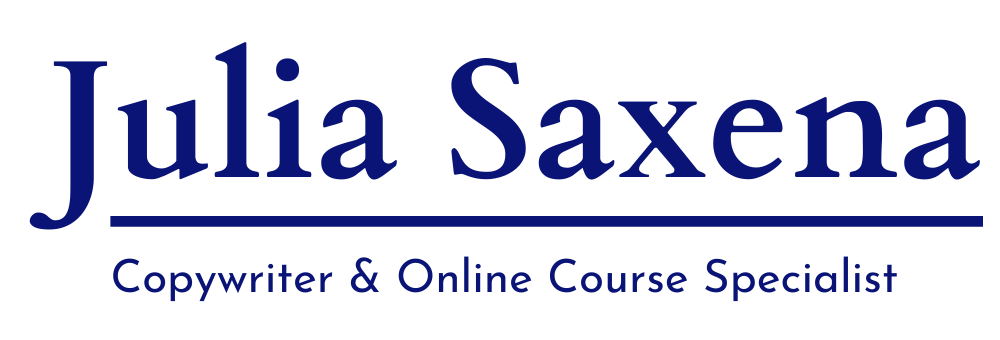So, you’ve got something to sell.
And now, you need to write that landing page, the email, or the ad that will hopefully *fingerscrossed* close the deal with your prospects.
Where do you start?
A blank page is never a good idea. So, here’s what to fill your Google Doc with.
Today, I want to show you the 6 elements you need to clarify before you get to the actual writing. Having these figured out will let the ultimate words flow way more easily. ‘
It’s called the Rule of One:
- ONE Reader
- ONE Offer
- ONE Promise
- ONE Transformation
- ONE Call-to-Action
- ONE Voice
I wish I could take credit for this badass name, but the concept was originally created by the one and only Joanna Wiebe of Copyhackers. This is my personal spin to the Rule of One and how I’m using it for my copywriting.
I’ll introduce each element and apply it to a real-life example: the sales page I’m writing for the Minimum Viable Video online course that my friend Cam Houser and I are launching right now.
(If video is something you think you “should” be doing in your business, then this is the right moment to get behind the wheel and make it a reality.)
1. ONE Reader
This is the one person you are trying to convert with your copy. It’s the person you want to reach and who will most benefit from what you have to sell.
“Can’t I just keep it more general, so I reach more people?”
Nope! We’ve talked about this before.
When you’re trying to appeal to everyone at once, you’ll end up converting no one. Because your message is too watered down to make a serious impact.
The argument you form in your copy has to be fully tailored to convince that one reader. So the more you know about your one reader, the better. On the basic level, you’ll need to know the …
- Pain points and challenges that you can help them overcome.
- Goals and aspirations that they’re working towards.
- Objections and limitations that are holding them back from achieving their goals.
Another thing to be aware of is what messages your one reader saw most recently that made them click through to your page (or the last email from you they’ve received). These messages have created certain expectations in your one reader. Now, you have to match these expectations with your copy.
The one reader for Minimum Viable Video:
Entrepreneurs and professionals who’re ready to invest in their skills. They want to stand out, advance their careers, and grow their businesses.
2. ONE Offer
This is the “thing” you’re selling. What is your one reader getting? That’s your offer.
Your copy has to make it crystal clear and not leave any doubt whatsoever. And it should drive your reader to one single offer – not two or three.
There are a few things you can do to make your offer more enticing. Here are 3 levers to pull:
- Discounts: Yes, they still work and can increase your conversion rate. If you’re giving a discount, make it a time-sensitive one. Having a perpetual price reduction “just because” feels icky.
- Guarantees: They are an excellent way to reduce the risk for your prospects. But a standard 30-day money-back guarantee doesn’t wow anyone anymore. Get specific with the actions your customer should take to get the most out of your product or service. And tell them exactly what they should do if they don’t achieve the promised outcome. To make your guarantee stand out, brand it! Give it a fancy memorable name.
- Bonuses: These have the potential to help on-the-fence prospects over the last hurdle. Bonuses work well when their perceived value is high and when they’re super relevant to your prospects at this point in their life. Bonuses could be, for example, a 1:1 session with you, an implementation guide, or templates. To create a sense of urgency, you can also let your bonuses expire.
The one offer of Minimum Viable Video:
4-week action-packed, feedback- and community-driven online course with 2 live classes per week and Video Sprints on the weekends.
Guarantee: You can go through the whole course, and if you don’t have at least 4 high-quality videos published that you’re proud of, and that have the potential to advance your career, then you can get a full refund. But, you have to at least show up to the sessions and put in the work.
3. ONE Promise
This is the outcome (ideally measurable) your one reader can expect to achieve with your product or service. It has to match what your reader actually wants.
Beware not to use puffery here…making the promise so big it can’t be true. We’ve all seen the “lose 20 pounds in one week” ads at some point. The promise has to be meaningful.
Here’s how you develop your one promise: Look at your offer and list all the benefits and outcomes your product or service provides.
In the case of the Minimum Viable Video course, these are…
- Discover what you’re capable of.
- Become a creator, not just a consumer.
- Find a new identity and show the world a new side of yourself.
- Make an impact with the greatest lever you have available right now: video.
- Make massive leaps in your video skills through quality feedback from your instructor and peers.
- Understand that quick feedback is invaluable when you want to produce quality work.
- Gain an entrepreneurial mindset focused on taking action and being comfortable with rejection.
- Master the technology involved in filming, editing, and publishing videos.
- Be part of a community of smart, like-minded people who push each other forward.
- Learn to churn out videos quicker than any other type of content.
- Grow your confidence and competence.
- Begin seeing the world through a new lens, where you talk about insights that you didn’t know you had.
- Get comfortable on camera.
- Produce high-quality videos you’re proud of.
- Celebrating a career win (like getting a raise, a new and better job, a new client).
Now, shortlist the promises based on their desirability and choose the one promise that’s strongest.
You can further optimize your promise to be measurable by adding a number, the speed with which the outcome will occur, or a success rate.
The one promise of Minimum Viable Video:
You’ll open up new opportunities for yourself that you never thought were possible when you start publishing videos that showcase your personality and expertise.
4. ONE Transformation
“We hard sell the transformation so we can soft sell the thing that provides it.”
Ry Schwartz
Copywriting builds the bridge that allows your prospect to confidently go from point A to point buyer.
But in order to cross that bridge and accept your offer, your prospect needs to believe, realize, and agree to certain beliefs. Without these beliefs in place, not even the most enticing features, benefits, bonuses, or special deals will have an impact.
It’s your job to challenge your reader’s beliefs and self-imposed limitations. To equip them with the new beliefs, understandings, and inner shifts needed to move forward. And to make this new reality feel exciting, believable, and safe.
If these beliefs are in place, then saying “yes” to your offer will be the most obvious and natural decision for them to make.
How big of a transformation you need to coach your reader through in your copy depends on their stage of awareness.
- Unaware – Your readers don’t even know that they have a problem, yet.
- Pain aware – Your readers know that they have a problem, but don’t know the solution.
- Solution aware – Your readers know what a solution can look like.
- Product aware – Your readers know that there are products out there that are the solution to their problem.
- Most aware – Your reader knows about your specific offer already.
The one transformation for Minimum Viable Video:
From: Everybody else is already so much better at this.
To: They’ve all started somewhere. You can be part of the game, too. What’s keeping you stuck is your fear, not ability. It’s not too late to get started. We’re still only at the beginning with video.
From: I can learn this on my own.
To: Sure, you can. But it will take a lot of time. And you’ll have to comb through YouTube and blogs to find the right information. Without accountability and feedback, it’s hard to make meaningful progress.
From: Getting the equipment to make it look good is expensive.
To: You already have it. Your smartphone is good enough to make high-quality videos. Basic equipment like microphone, tripod, lighting is cheap and easily accessible.
From: I’m not sure that this is worth the money.
To: Hiring a videographer will cost thousands of dollars for one single video. You’ll have to schedule it and write a script. And when that video is outdated, you’ll have to start over again. Learning to make great videos is an investment in yourself.
Now, how do you coach your prospects through this transformation? You can make it part of your email sequence leading up to your launch. Address one belief per email and help your prospects reframe it. You can also address the beliefs directly on your sales page before making your offer.
5. ONE CTA
What do you want your reader to do next? Every piece of copy should have one CTA only, one clear action that you’re leading them towards.
Your CTA is the point where all the work you’ve done to highlight the value of your solution and overcome your reader’s objections comes together in a single action they should take. It’s the point at which the conversion happens…or not.
And that means, in most cases, clicking a button.
At this stage, many writers are tired and resort to standard phrases like “Download,” “Sign up,” or “Learn more.” This sounds not only very dry and boring but also like work for the reader.
Instead of telling them what obviously comes next (every person on the internet can already guess), remind them of the value of proceeding. Think of the call-to-action as a call-to-value. What will they really get when they click on the button?
Need a reminder of the value you’re providing? It should be in your headline!
The one CTA for Minimum Viable Video:
Transform your life with video
6. ONE Voice
What do you want to sound like? Your voice is the personality that you infuse into your writing. It sets the mood and gives your sales page or email a certain vibe.
Having a consistent brand voice across all your communication helps to develop brand recognition with your audience.
While it’s smart to keep the overall voice consistent, you can vary your tone based on the piece of copy you’re writing. Tone is the emotional inflection you apply to your voice.
If you’re curious how to develop your brand voice, check out this blog.
The one voice for Minimum Viable Video:
Encouraging, direct, conversational, confident.
Questions? Feedback?
I’d love to hear from you. Send me an email at julia@juliasaxena.com.






